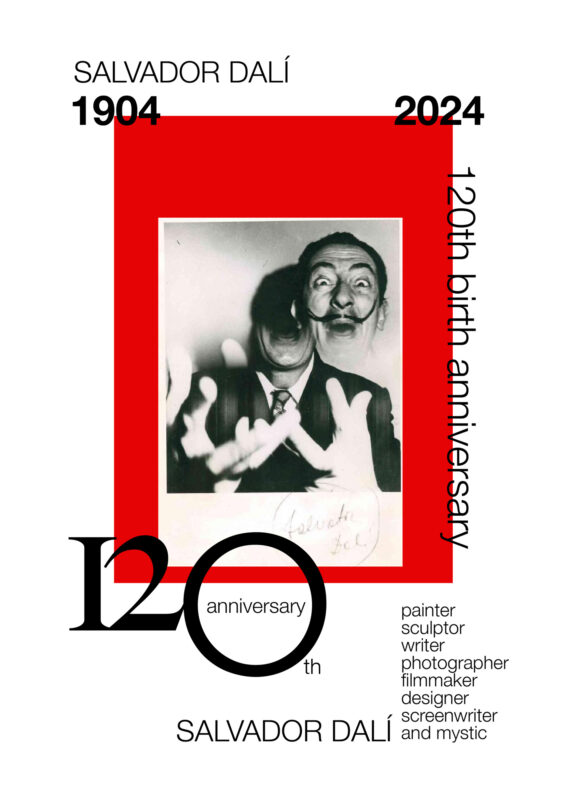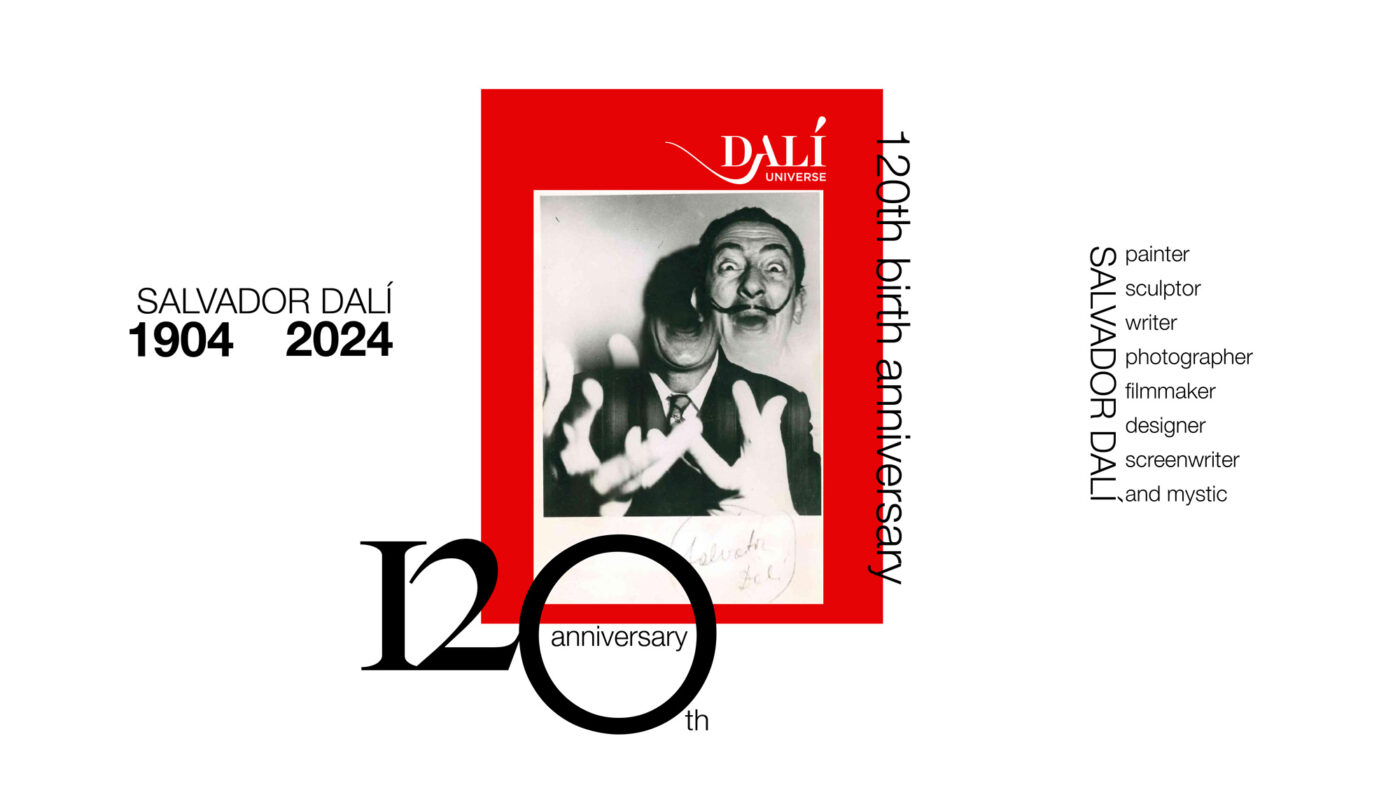YOUTHFUL YEARS
1904 – Born in Figueres, Spain, on May 11; his first painting, a landscape, bears the date 1910.
1914 – Began high school studies at the Marist Brothers’ school in Figueres, where he began to take an interest in painting and was particularly influenced by Ramon Pixtox (1872-1925). For the most part, Dalí’s early works consist of landscapes and genre scenes depicting peasants and fishermen.
1921 – Dalí enrolled at the San Fernando Academy of Fine Arts in Madrid; here he met Lorca, Buñel and Montes and was influenced by the Italian Futurists, Bonnard and Eugène Carrière.
1922 – Exhibits at the Galeries Dalmau in Barcelona. In Paris André Breton, together with Picasso, Max Ernst and Man Ray, founded the first Surrealist group.
1923 – Arrested for anarchist tendencies and held in jail for 35 days; developed interest in Cubism and the Italian metaphysical school (Carrà and de Chirico).
1925 – First solo exhibition in Barcelona; both Picasso and Miró show interest in his art; Dalí begins to collaborate with the Barcelona magazine “L’Amis de les Arts,” a relationship that will last until 1929.
1926 – Dalí visits Paris (where he meets Picasso) and Brussels; he is expelled from the Academy of Fine Arts; Miró visits Dalí in Cadaqués; second solo exhibition at Galeries Dalmau; interest from critics and public grows.
1927 – Dalí performs military service; spends the summer in the company of Lorca and Regino Sàinz de la Maza; writes the poem “San Sebastian,” which is published in “L’Amis de les Arts.”
1928 – Lluis Montanyà, Sevastià Gasch and Dalí publish the revolutionary Yellow Manifesto; his work is influenced by Miró, Arp, Ernst and Tanguy. Three of his paintings are exhibited at the 27th Carnegie Institute Painting Exhibition, Pittsburgh, United States.
1929 – Dalí is in Paris to work on Buñuel’s film. Un Chien Andalou (An Andalusian Dog), which causes a sensation; Miró presents Dalí at the Surrealist Group where he met Magritte, Paul Eluard and Helena, who would later become his wife Gala; Dalí’s first exhibition, presented by Breton, was held at Galerie Goemans in Paris.
1930 – “Le Surréalism au Service de la Révolution.” public Reverie, one of Dalí’s most important texts; ten of Dalí’s works are exhibited in what must be considered the first Surrealist exhibition in the United States; Dalí publishes the text L’Ane Pourri in which he lays the foundations of his paranoid-critical method.
1931 – First of three exhibitions held over the next three years at Galerie Pierre Colle.
THE PERSISTENCE OF MEMORY AND NEW YORK
1931 – The Persistence of Memory arouses enormous curiosity among New York art gallery goers in a group exhibition at the Julien Levy Gallery in New York.
1933 – Dalí signs a contract with Albert Skira, committing to create forty drawings for Lautréamont’s Les Chants de Maldoror; first solo exhibition at Julien Levy Gallery in New York; in December Dalí exhibits at Galeria d’Art Catalònia in Barcelona.
1934 – Exhibits at the Salon des Indépendants Dalí, Julien Levy Gallery, Galerie Jacques Bonjean, Carnegie Institute and ZwemmerGallery in London – his first solo exhibition in Britain; Gala and Dalí travel to New York for the first time; lectures at the Wadsworth Atheneum in Hartford, Conn.
1936 – The Surrealist Exhibition of objects presented at the Galerie C. Ratton in which Dalí participated marked the “officialization” of a new expression of Surrealism; he returned to N.Y. and his picture appeared on the cover of ‘Time’ magazine; he exhibited again at the Julien Levy Gallery and in a group show at the Museum of Modern Art entitled “Fantastic Art, Dada and Surrealism.”
1937 – Dalí’s writings in which he develops the concept of Surrealism continue to be published widely; after Lorca’s assassination in ’36, at the outbreak of the Spanish Civil War, Dalí took refuge in Italy where he was influenced by the Renaissance and Baroque art.
1938 – Participates in Surrealist exhibition at Galerie des Beaux Arts, Paris; meets Sigmund Freud in London; collaborates with Coco Chanel on several ballet designs for the Ballets de Monte Carlo.
1939 – New York, exhibition at Levy Gallery; signs a contract with the New York International Exposition to create The Dream of Venus but has disagreements with sponsors about his ideas. Following these disagreements, when he was prevented from putting a fish head on Botticelli’s Venus, he published his “Declaration of the Independence of Imagination and Man’s Right to His Own Insanity”; Dalí designs the sets for the first paranoid ballet, Bacchanal, which is performed at the Metropolitan Opera House; Gala and Dalí return to Europe and settle in Arcachon; the Spanish Civil War ends with General Franco’s victory.
1940 – With the onset of World War II, Dalí left Europe for Virginia and stayed at Caresse Crosby’s house; he later settled in Pebble Beach, California; Dalí remained in the United States until 1948.
1941 – Dalí is very successful in America; begins a prolific collaboration with photographer Philippe Halsman, which will end with the latter’s death in 1979; Dalí finishes writing My Secret Life, published in 1942; Dalí produced libretto, sets and costumes for the ballet Labyrinth at the Metropolitan Opera House.
1942 – Retrospective exhibition at the Museum of Modern Art is replicated in eight other American cities.
1943 – Dalí becomes a welcome member of New York society; paints portraits of wealthy Americans for the Knoedler Gallery and makes the famous face of Mae West.
1944 – Theater activities intensified and began working on illustrations for several books.
1945 – The atomic bomb explosion at Hiroshima inspires Dalí to begin his “nuclear” or “atomic” period; he works with Alfred Hitchcock on the dream sequence of “Spellbound (I Will Save You).”
1947 – Dalí illustrates an edition of Montaigne’s Essays and has a solo exhibition at the Cleveland Museum of Art and later at the Bignou Gallery in New York.
1948 – Leaves for Europe to settle permanently in Portlligat; exhibits at the Galleria l’Obelisco in Rome; enters a new phase, in which he no longer has points of contact with the postwar avant-garde but, on the contrary, focuses on the great themes of the Western tradition.
1949-Designs sets for Strauss’s Salome at Covent Garden, London; grows his interest in harmonic and geometric theory; returns to New York.
1950 – Dalí gives the book “Memorandum” to prints in response to his sister’s book; designs sets and costumes for Don Juan Tenorio Zorrilla at the Teatro Maria Guerrero in Madrid; many of his designs from this period are influenced by religion and mythology.
1952 – Dalí explains the elements of nuclear mysticism on a tour that touches seven cities in the United States; he is commissioned to illustrate The Divine Comedy to mark Dante’s anniversary, for which he does 102 watercolors.
1954 – Major retrospective of Dalí’s work in Rome (Palazzo Pallavicini) and later in Venice and Milan.
1958 – Begins ‘optical art,’ researching optical effects and illusions; Gala and Dalí marry in the ‘Chapel of the Angels’ in Spain; Dalí is awarded the Médaille à la Qualité Francaise by the Cuban Ambassador to Paris for his series of illustrations of Don Quixote (1957).
1959 – Dalí meets Pope John XXIII.
1960 – Surrealists write the article We don’t hear it that way against Dalí’s participation in an international exhibition on Surrealism in New York; begins work on “The World of Salvador Dalí” with Robert Descharnes.
1962 – Dalí concentrates more and more on the main themes of his past career, which he continually reexamines and reworks; Descharnes publishes Dalí de Gala.
1963 – Exhibition of most recent works at Knoedler Gallery, New York; publication of Millet’s The Tragic Myth of the Angelus, written in 1933.
1964 – Dalí is awarded the Grand Cross of Isabella the Catholic; publication of Diary of a Genius; major retrospective in Tokyo, Japan, organized by Mainichi newspaper.
1965 – New York’s Gallery of Modern Art exhibits never-before-seen paintings from Reynolds Morse’s private collection; Dalí illustrates the Bible with 100 watercolors; develops an interest in holography and three-dimensional art.
1968 – Publication of Les Passions Selon Dalí and Dalí de Draeger.
1969 – Publication of Las Metamorfosis Eròticas, one of the pinnacles of his paranoid-critical method; exhibition at Knoedler Gallery arouses great interest in the American press; Dalí announces the creation of the Dalí Museum in Figueres; he works on commercial posters for the Perrier, Lanvin chocolate and French Railways companies; the Boymans-van Beuningen Museum in Rottedam organizes the first of the major retrospectives in Europe.
1971 – Official opening of the Dalí Museum in Cleveland, consisting largely of the Morse Collection.
1973 – Dalí’s “Holographic Room” is put on display; Dalí illustrates Dix Recettes D’Immortalité and Roi Je t’attends à Babylone.
1974 – Retrospective at the Stadel Museum in Frankfurt; opening of the Dalí Theater-Museum.
1978 – New York’s Guggenheim Museum presents Dalí’s first hyper-stereoscopic works; Dalí is named a foreign associate member of the Académie Francaise des Beaux-Arts.
1980 – Major retrospective at the Tate Gallery in London; Dalí delivers a portrait of the King of Spain to the Zarzuela Palace in Madrid.
LAST YEARS
1981 – Dalí slowly recovers from an illness contracted in New York; concerned about his health, King Juan Carlos and Queen Sofia of Spain visit Dalí at his home in Portlligat.
1982 – Attends the official opening of the Dalí Museum in St. Petersburg, Florida, founded by Morse; the Honorable Jordi Pujol, President of the Autonomous Government of Catalonia awards Dalí with the government’s gold medal; Gala, Dalí’s wife, dies June 10 after more than fifty years together and is buried at Púbol Castle; Dalí paints his last paintings; after his wife’s death, Dalí abandons public life and isolates himself in his Púbol Castle.
1989 – Death of Dalí: Salvador Dalí dies at the age of 85 on Jan. 23.


